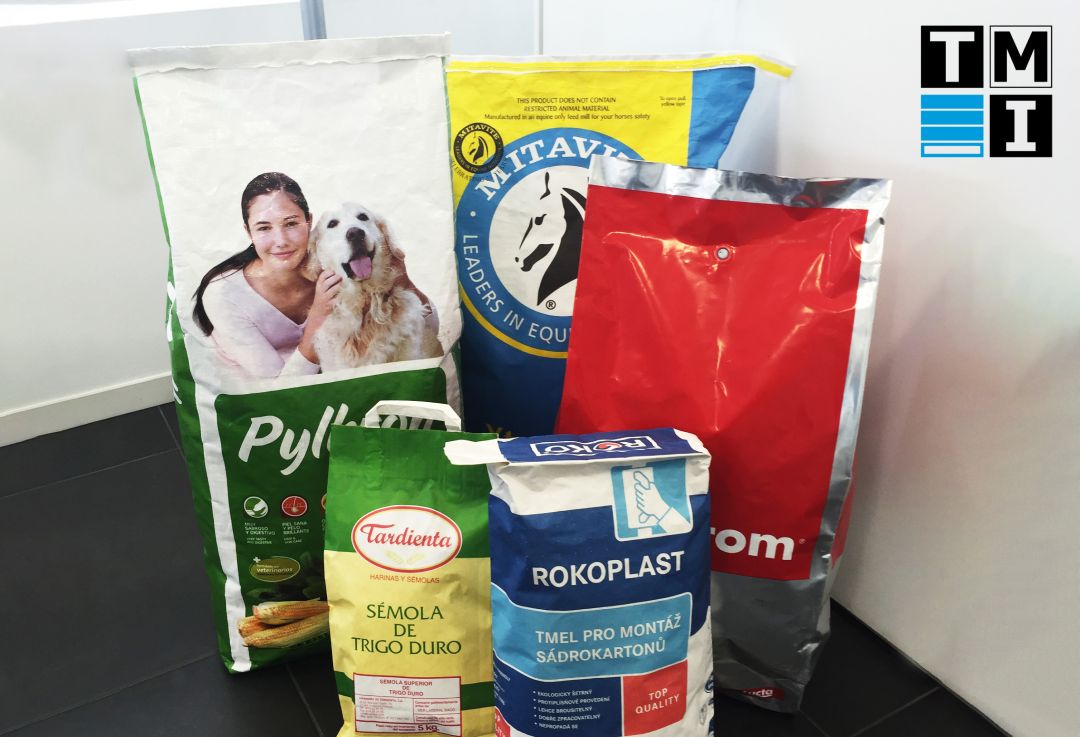GUIDE TO CHOOSING THE BEST TYPE OF BAG FOR YOUR PRODUCT
To choose the right bagging machine for your project, the first question you need to ask yourself is: what kind of bag will the product be packaged in? This question is not as straightforward as it seems, as many of our clients ask us for advice on what bag they should use for their product.
Giving a precise answer is not always easy, as bag configuration is a complex subject. That is why, in this article, we will try to shed some light on the criteria you should consider when choosing the packaging for your product.
WHAT KINDS OF BAGS ARE AVAILABLE?
Bags are mainly categorised according to their shape and the technology needed to manufacture them, which can vary enormously from bag to bag. For solid products, bags come in the following formats:
Open-mouth bags
This is a sack-style bag made of paper, polythene (PE), or polypropylene (PP), either on its own or combined with layers of other materials. As its name suggests, the top of the bag is open, which is where the product goes in.
It is worth noting, though, that there are several types of open-mouth bags: with or without gussets, sewn, pinch or square-bottom, and SOS (self-opening) bags… We could go on.
But the main aspects to consider about this type of bag are:
- The desired end result: Bags with gussets and bags without gussets need to be handled in specific ways. What is more, open-mouth bags can have different closure systems, depending on the kind of product you need to bag. With this in mind, the question is: how do you want your bag to look?
- Line automation: If you are planning on using an automated line, the bags you choose must be suitable for this purpose. For instance, if you opt for a polypropylene bag, it must be a laminated, cold-cut on the upper part.
- Product characteristics: The properties of your product will have a major influence on the type of bag and material you choose. If you are bagging a high-value product, or that gets damaged if it comes into contact with moisture or air, you will need to select materials with protective barriers and partially hermetic seals.
Valve bags
Valve bags are rectangular and not entirely open: the product (flour, mortar, plaster, chemicals, etc.) is inserted into the bag through an opening (the valve) located at one of its corners. This minimises the chances of dust escaping and ensures that the closure is as small as possible.
Some valve bags do not need to be sealed – as is the case in the construction sector – or they may need a heat-sealed closure, especially in the food industry. In this case, you will need bags with a heat-sealable valve coated in a material like SURLYN, EVA or SUPRA.
In addition, some valve bags are suitable for automated lines, and others are not. If automated valve bag filling is your goal, you need to consider criteria like the bag’s porosity, the characteristics of the valve opening, the quality of the glued seals, the finish… If you are not nd the mouth need to be sealed, and not the sides. sure about any of these elements, your valve bag supplier will be able to help you.
Flat roll FFS
Rather than a type of bag, this is a kind of bag-forming technology. If you have an FFS-type bagging machine, instead of asking your supplier to send you 10,000 FFS bags, you will order your desired quantity of flat film rolls. The machine itself makes the FFS bags out of this film. Indeed, the initials ‘FFS’ mean Form, Fill, and Seal. All three actions occur in the same process, which is the main advantage of FFS baggers.
Vertical FFS bagging machines use flat PE film, which can carry however many protective layers the product needs, to form a bag through what is known as a forming tube and various heat-sealing points. This way, the size of the bag is regulated according to the format, so the bagged product is standardised.
Because of their shape, these bags are also known as pillow sacks. A side gusset-forming mechanism can be incorporated into your machine if you would like a more rectangular bag.
Tubular reel FFS
This type of bag is also formed by the bagging machine itself. Unlike the previous type we looked at, this kind of bag comes from a tube of PE, so only the bottom and the mouth need to be sealed, and not the sides.
The tubular or horizontal FFS bagging machine can therefore take on higher production levels at a steady rhythm.
The bags it produces are compact and rectangular, which makes palletising and logistics operations much easier and reduces packaging costs.
WHAT MATERIALS ARE THE BAGS MADE FROM?
There is no end to the materials that can be used to make bags, but they all serve different purposes. Some are used as a coating, others for printing effects, for easier closure, or to make the bag stronger. Some can even help your product to last longer.
Broadly, though, the basic options to which these other materials can be applied are:
- Paper
- Polythene (PE)
- Polypropylene (PP), also known as woven bags
- Aluminium foil
All of them can be accompanied by various layers and coatings, but their essential characteristics differ, so they are used for distinct purposes. Paper, for example, is the best choice for valve bags to be used in an automated process, as its porosity allows the air pumped in through the valve to escape, while PE is ideal for products that require as much protection as possible from moisture and changes to their environment. PP bags, meanwhile, allow your products to ‘breathe’ and are strong, which is an especially important quality in manual handling processes.
Several factors will determine whether you should choose one material or another, so let us take a look at them:
WHAT FACTORS ARE INVOLVED IN DESIGNING A BAG?
Protecting the product
If your product calls for airtight packaging or protection from sunlight, you will need a PE bag, which can be treated with one or more layers of another material depending on the level of protection required (aluminium foil, for example). Paper is also a good option for keeping out light, but not air or moisture, unless it is combined with inner layers of foil or PE. Finally, PP or woven bags enable the product inside to breathe.
Added value
The more sophisticated the bag, the higher its cost, logically. As you know, the price of the product will end up reflecting this cost. So, when choosing your bag, make sure your product can take this price increase.
Production level
Pre-made bags will always require more handling than bags formed from a roll. If your required production level is high, an FFS bagging machine could be the perfect solution. For small-scale production, though, any of the pre-made bags mentioned above could suffice.
Hygiene
When you work with powder products, it is important to think about the level of hygiene you need in your plant. For micronised products, valve bags can pose a problem: some particles may escape through the pores in the paper due to the high air pressure used to insert the product into the bag. In this case, a PE bag (with or without aluminium foil) would be a better option.
If you want to use an open-mouth bag, you will need to check that the filling spout on the bagging machine you are going to use is airtight, especially if your product is a powder.
Number of products and formats
If your line only produces one format – 25 kg bags, for instance – you will have no problem using pre-made bags, as you will always need the same consumable.
But say you make 10 distinct products, with varying densities, and each comes in 5 kg, 10 kg, 20 kg, and 25 kg formats. This will require roughly 20 to 40 types of bags, without taking into account the number of markets in which you sell your products. In this scenario, your consumables will take up a lot of space, and you will have to keep an eye on your stock of 40 different bags. These problems disappear if you use an FFS bagging machine, as it can make all sorts of formats with a single consumable by simply regulating the bag measurements. A prior standardisation process will be required, though.
HOW CAN TMI HELP YOU?
As you can see, every case has its own specific needs. The team here at TMI would advise you to ask various bag manufacturers about the materials and options they can offer you. As bagging machinery manufacturers, we can also provide technical guidance on the pros and cons of different bag types combined with each bagging system we make.
Then, the next step would be to analyse your product’s performance. We do this in the TMI lab at the beginning of all our projects. As well as giving you a better idea of the type of bag you need, this process will provide information on the recommended dosing, whether or not you need a deaeration probe, how airtight you need the bag and filling spout to be, and more.
If you would like some advice on this subject, send us the details of your product and we will be delighted to help.


